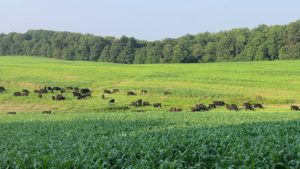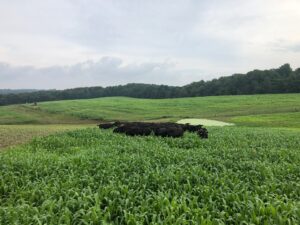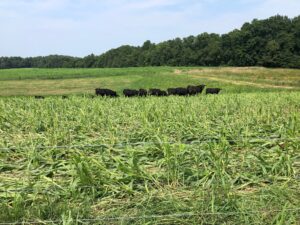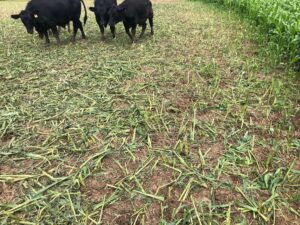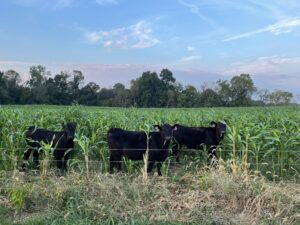Final report for FNC21-1271
Project Information
We raise beef cattle and sell direct to restaurants, universities & individuals. Our primary farm is 750 acres and we rent and cooperatively manage an additional 1,500 acres with approximately 10 farmers. We raise our cattle naturally, without use of growth hormones, ionophores and no antibiotics within last 6 months and if required therapeutically. Our cattle are born on predominantly fescue pasture, weaned onto ryegrass pasture in late fall & spring. Then fed corn silage & grass silage mixed with distillers grains to finish.
We intend to use the grant funds to aid in the transition of row crop ground into regenerative pasture for our cattle through the use of summer forages that are known for improving soil health and carbon sequestering, specifically sorghum sudangrass. Growing corn and other row crops on our rolling hills in Indiana contributes to runoff and deterioration of soil nutritional value. Soil health has been depleted in the United States due to poor field management that focuses on short term yields and profitability over long term soil health and sustainability. The intent of this project is to offset some costs associated with making the transition and to show our extended network of farmers the positive impact.
Sequestering carbon from the air is one of the best opportunities we have to reverse global warming and offset fossil fuel emissions. In addition to the environmental impacts, ongoing operational expenses will also be lower due to lower seed costs and reduced equipment costs. The conversion from cropped acres to cattle pastures with purposeful herd management (e.g., rotational grazing, pasture finished) creates a more balanced ecosystem with healthier soils, healthier cattle, and overall a more sustainable operation for farmers and their families.
- Evaluate the impact on soil health of new forages and rotational grazing.
- Evaluate cattle health (i.e., body condition score, illness rates, rate of gain) on tested forages.
- Determine appropriate forages for regional climate and terrain.
- Assess economic viability of transition from row crop to pasture (input costs vs. feed value and offset costs such as reduced fertilizer, herbicide, and insecticides).
- Share findings to farmers and end customers via blog posts, social media, and conferences.
Cooperators
Research
Location: We will conduct the study in two fields, totaling approximately 50 acres that has been planted in corn each year for 20+ years. These fields are situated behind Dave and his wife Diana’s house which will make regular observation and documentation convenient.
Seed Mixture: We will use a mixture of sorghum sudangrass and red clover. We plan to test different ratios of these seeds to determine the most successful balance for our fields.
Equipment: A no-till drill will be used to plant the forage for this project. We will get a better stand using no-till drill vs. broadcast seeding.
Water System: We will install quick connectors to buried water lines that will allow us to easily move water troughs with the cattle to each of the smaller paddocks. This will provide greater flexibility in field layout and be more cost effective than permanent solutions.
Grazing Management: The fields will be subdivided into smaller paddocks, approximately 2-3 acres in size using temporary fencing. Cattle will be moved daily or every two days depending on forage growth/consumption rates. Existing lean-to shelters will provide shelter from inclement weather and shade during hot summer days.
Soil Testing: Fischer Farms has worked with Superior Agriculture Cooperative for many years to conduct soil tests. These will be conducted before and after the study to establish a baseline and show progress. Superior Agriculture and Fischer Farms also both maintain soil test records of each of the fields on Fischer Farms property for comparison purposes as needed.
Because of the drought, we weren't able to measure results for the grazing in 2022. We plan on doing more detailed analysis in 2023, including comparing the summer annuals to grazing fescue/clover pasture.
Educational & Outreach Activities
Participation Summary:
I included our network of farmers in the project. Both in the initial design and in the actual results. This also includes our 3 full-time farm employees. All the farmers I have listed as cooperatives; Owen Snodgrass, Alex Lueken & Tyler Gehlhausen. Approximately 5 other farmers who did not want to be listed but either walked through the fields with me or were involved in planning the experiments.
Learning Outcomes
Last year was our first attempt to graze sorghum-sudan grass and we learned a couple of key items:
- Our cattle density was too high and their starting weights were too large. We started with a group of 120 800lb calves and divided the group in two. The control group we fed our normal corn silage and distillers diet. The other group we grazed on sorghum-sudan grass. We had 30 acres for this group to graze but it wasn't enough to keep good quality forage in front of them each day. We experimented with strip grazing and gave the resting grass more time for regrowth. After the ground was strip grazed the sorghum-sudan grass did not regrow. The calves grazed the grass below the regrowth point. So we switched to larger paddock grazing which worked better but still the calves ran out of top quality forage to graze. We supplemented these calves with time periods of corn silage + distillers grain. Among our comparison groups the grazed group had a lower body condition score.
- The acreage required for grazing was much more than we expected and 4 times the amount required if we would have grown forage sorghum for silage and fed this to the cattle. With the current prices of land, land usage is a critical constraint and this is our biggest challenge in implementing finished grazing for a majority of our cattle.
- We did see health and well being benefits to the cattle, especially at younger ages. We have since moved most/all of our cattle that are under 700 lbs to grazing with rye grass grazing November through June and plan to graze sorghum-sudan this summer June-October. We feel this will both benefit their health and reduce the overall acreage required per calf raised. So current plans are to graze from after weaning 600 lbs to up to 800lbs based on available forage. Then after 800 lbs to finish on corn/forage sorghum silage with distillers grain.
Project Outcomes
We struggled last year because we had a drought that started the end of May and went until July 7. We planted Sorghum sudan near June 15 but we got a very poor stand because of the drought and the weeds took over. We didn’t use any broadleaf control because we planted peas, buckwheat with the sorghum sudan. We replanted the fields in forage sorghum on July 20 after the drought was over and harvested these fields as silage because of the short time frame we had before getting our rye grass planted in late September.
We also had a key learning in 2022. We have struggled getting a consistent stand with drilling in the sorghum seeds. We planted a late crop of forage sorghum on Aug 20, 2022 and used our corn planter with splitter rows. We had to get small seed plates and do some other modifications to the planter, but we got excellent results. Seemed like almost every seed germinated. Our agronomist attributed the difference to the soil-to-seed contact was so much better using a corn planter. So we plan on using the corn planter to plant 60 acres or more this summer. A new area we want to try is planting sorghum sudan directly into fescue pastures in July, I feel with the corn planter it will be very successful.
We will continue to experiment to plant the sorghum sudan in June, will use broadleaf control, plant with our corn planter and graze based on the lessons we learned in 2021. We also have a farmer field day planned August 11, 2023 with our county cattlemans association to demonstrate the results and expect over 50 farmers to attend.
Our key lessons learned:
- Plant into tilled soil (which we avoid any tillage) or plant with a no-till corn planter (preferable). We believe the no-till planter will give us good stands in no-till because of the improved soil-to-seed contact versus a drill.
- Strip grazing led to the cattle grazing the sudan grass to the ground which stopped regrowth.
- Giving the calves too big of a paddock (15 acres for 60 head was too big), resulted in lots of sudan grass getting knocked over.
- It seemed that about 5 acres for 3 days was about the right rotation. We are going to start at this level for 50 or so head and then try bigger and smaller paddocks and quicker turns for future seasons.
